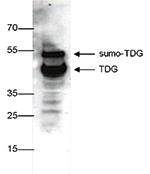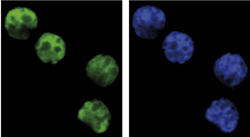TDG (UniProt/Swiss-Prot entry Q13569) belongs to the TDG/mug DNA glycosylase family. It removes thymine moieties from G/T mismatches by hydrolyzing the carbon-nitrogen bond between the sugar-phosphate backbone of DNA and the mispaired thymine. It is also able to remove thymine from C/T and T/T mispairings, although with lower activity. Furrther, TDG plays a key role in active DNA demethylation as it binds to 5-formylcytosine (5fC) and 5-carboxylcytosine (5caC), but not 5-hydroxymethylcytosine (5hmC), and mediates their excision through base-excision repair (BER) to install an unmethylated cytosine.
-
产品
剪切技术
Tagmentation
Chromatin studies
DNA methylation
- Bisulfite conversion
- Methylated DNA Immunoprecipitation
- Methylbinding domain protein
- Hydroxymethylated DNA Immunoprecipitation
Genome editing (CRISPR/Cas9)
Antibodies
- All antibodies
- Sample size antibodies
- ChIP-seq grade antibodies
- ChIP-grade antibodies
- Western Blot Antibodies
- DNA modifications
- RNA modifications
- CRISPR/Cas9 antibodies
- CUT&Tag Antibodies
NGS Library preparation
- Library preparation for ChIP-seq
- Library preparation for RNA sequencing
- Library preparation for DNA sequencing
Automation
Reagents
- 服务
- 研究领域
- 资源
- 公司
-
联系人




